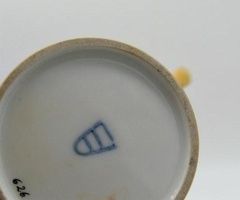Изготовитель Венский фарфоровый завод,
Купить фарфор Венский фарфоровый завод, Роял Вена, Royal Vienna. Продажа фарфоровых изделий на art-picture.ru
- Вначале высокая цена | низкая цена
Изготовитель Венский фарфоровый завод, Роял Вена, Royal Vienna

Венский фарфоровый завод — одно из старейших предприятий по выпуску фарфора в Европе (на втором месте после Мейсена). Его основали в 1718 году близ Вены (местечко Альзергрунд). Тонкостенная керамика ценилась тогда дороже золота. Рецепт мейсенского фарфора хранили в строжайшей тайне. Тех немногих людей (заводских химиков-технологов), которым он был известен, называли арканистами, что в переводе означает «чародеи».
Саксонскому князю Клавдию Дю Пакье удалось переманить из Мейсена в Вену нескольких мастеров-фарфористов и с их помощью создать вторую в Старом Свете фарфоровую мануфактуру. Императорский двор был заинтересован в развитии производства, которое должно было составить конкуренцию китайскому фарфору и обеспечить пополнение казны. Предприятие получило монополию на производство «белого золота» во владениях Габсбургов. Но несмотря на мощную государственную поддержку завод увяз в долгах. В середине 1740-х годов его выкупила императрица.
Изделия отличались от продукции Мейсенской мануфактуры, были не белоснежного, а кремового цвета, их ярко раскрашивали глазурями. В стране не было запасов каолиновых глин, благодаря которым масса получалась ослепительно белой. В период с середины 1740-х до середины 1780-х гг. мануфактура производит небольшие скульптуры. Изображали жанровые бытовые сценки: девушки с букетами цветов, дети с игрушками и конфетами. Для продукции того времени характерен стиль рококо. Мастера тщательно прорабатывали элементы одежды: кружева, банты на туфлях, локоны, складки. Придавали героям оживленные позы. Изделия не маркировались. Возможно, автором скульптурных форм был сам управляющий.
Император Иосиф II желал продать убыточный завод, но покупатель не находился. Он принял решение найти толкового управляющего. Таким человеком стал Конрад Зоргенталь. Он уже вывел два предприятия, принадлежавших императорскому двору, на безубыточное производство. К тому же Зоргенталь обладал превосходным художественным вкусом. Он сделал ставку на сложную роспись по фарфору, чтобы отличаться от своих главных конкурентов — Мейсена и Серва. Художники стали творить в стиле классицизма, копировать античные сюжеты. На завод принимали только лучших выпускников Венской Академии Искусств. Один из них в начале 1790-х годов изобрел ярко-голубую краску. Предприятие стало приносить прибыль.
Благодаря художнику К.А. Котгассеру в росписи тонкостенной керамики появились элементы бидермейера. Этот стиль появился в европейском искусстве в первой половине 19 века. Его считают переходным между неоклассицизмом и романтизмом. Стиль сочетает в себе пышность ампира с камерностью и сентиментальностью романтизма и идеализма, отражает вкусы нового буржуазного класса. Фарфористы декорировали изделия пейзажами, создавали предметы с монохромной росписью «под гравюру» (гризайль).
В 1780-1790 гг. скульптурной, а позднее и живописной мастерской руководил А. Грасси. При нем стали изготавливать бисквитные фигуры и бюсты. Помимо традиционных мифологических сюжетов появились «помпейские» мотивы, воспроизведение картин знаменитых художников того времени.
Из-за Наполеоновских войн предприятие оказалось на грани краха. Благодаря Венскому конгрессу, на котором присутствовали страны-победительницы, наметился некоторый подъем. Монархам иностранных государств преподносили роскошные подарки из «белого золота», они с удовольствием посещали мануфактуру. Но в 1864 году предприятие закрывается, не выдержав конкуренции с дешевым чешским фарфором. Традиции Венской мануфактуры продолжил Аугартенский фарфоровый завод, открытый в 1923 году.
Die Wiener Porzellanmanufaktur (Kaiserlich privilegierte Porcellain Fabrique) war eine Porzellanmanufaktur in Wien-Alsergrund, die 1718 gegründet wurde und bis 1864 bestand; sie war nach Meißen die zweitälteste Porzellanmanufaktur Europas.

